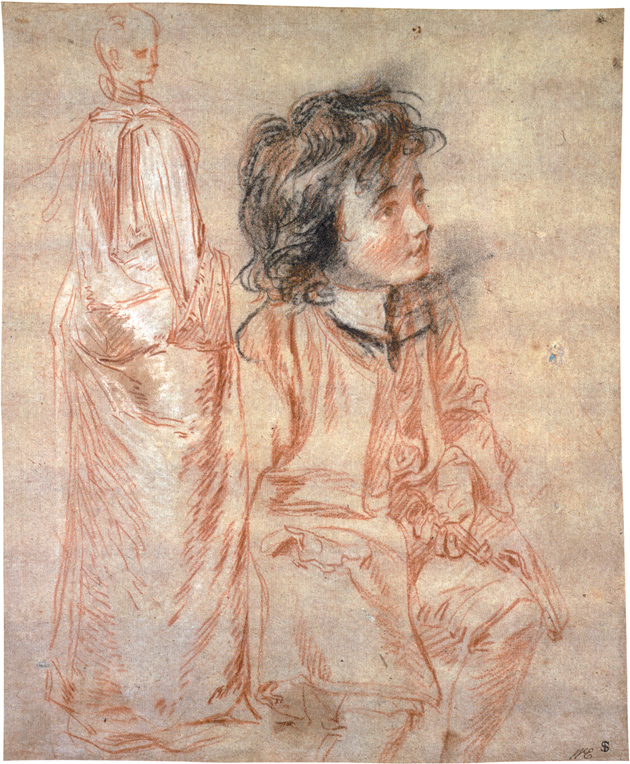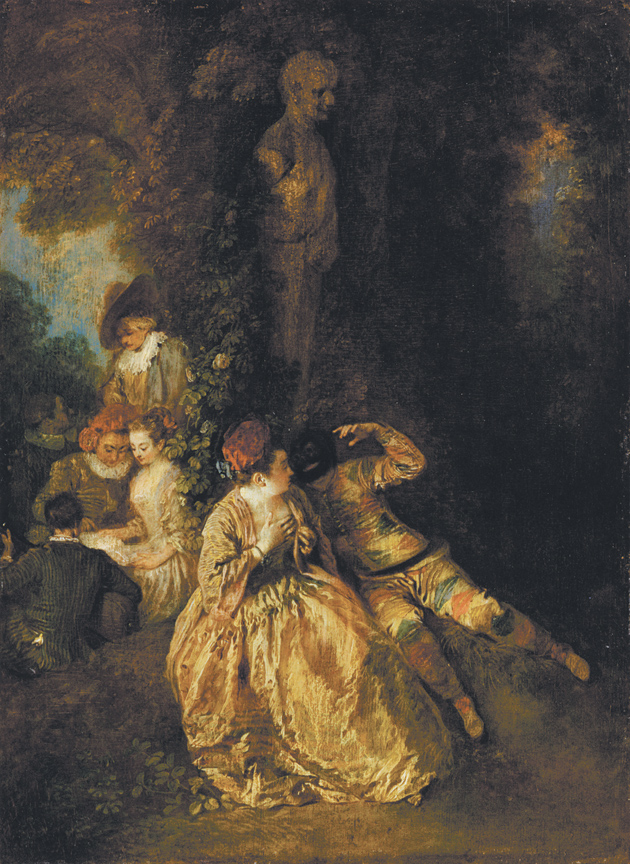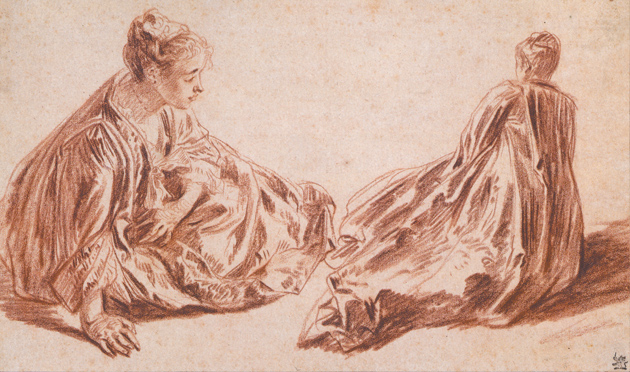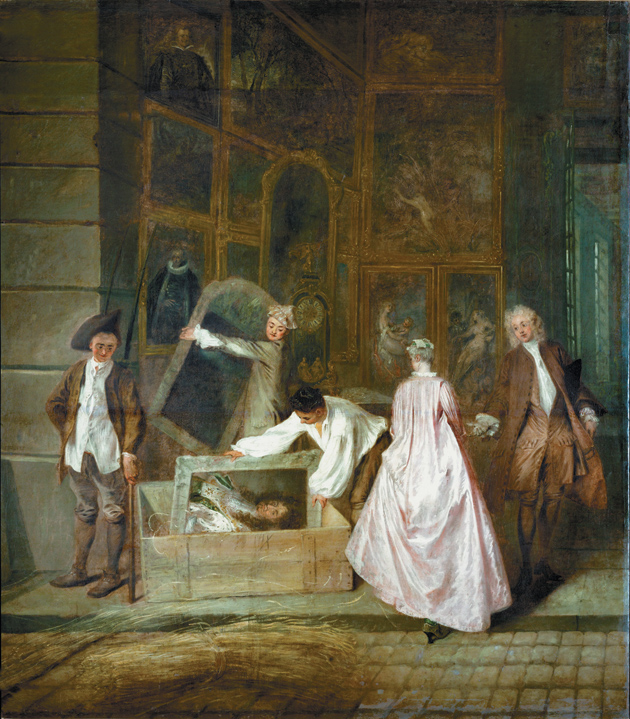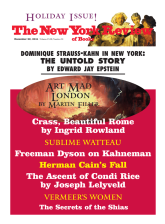1.
The recent and remarkable exhibition “Watteau: The Drawings” was housed in the Sackler Wing, completed in 1991 to expand the exhibition space of London’s Royal Academy of Art. The galleries suited Jean-Antoine Watteau’s drawings to perfection. The walls were painted a pale French gray and each drawing was given space in which to breathe.
In view of the fame that Watteau’s art attracted during the eighteenth century, his short life is not well documented and we do not know all that much about him. He was born in Valenciennes in either 1684 or 1685. His origins were humble and he was not very educated, but he was intelligent and became quite well read. Before it was annexed to France, Valenciennes had been a Flemish canton under the dominance of Flanders and Spain. Some of his early critics viewed him as a Flemish artist.
In 1702 he reached Paris, where he rejected the florid extravagance of the court of Louis XIV and then proceeded to turn himself into a French artist of a new mode. He worked for a while for an art dealer in premises near Notre Dame. There he made copies of work by Gerard Dou. Ironically, in view of Watteau’s fixation with youth and beauty, they were of an elderly woman wearing reading spectacles. He moved on to work in the studio of Claude Audran III, a celebrated decorative painter who became head curator of the Palais du Luxembourg, which then housed Rubens’s famous cycle The Life of Marie de Médicis. Watteau sketched from it and he had astonishingly natural gifts as a draftsman from the very start.
In private life, although he made some friends, he was basically aloof and self-contained. He was constantly changing his quarters, probably because of disagreements with his various landlords. His facility as an artist also seems to have caused jealousy among his contemporaries. He never executed a self-portrait but he posed for François Boucher1—holding a sketchbook—and Rosalba Carriera did a lovely miniature of him. Watteau comes across as being somewhat detached, well dressed, very elegant. During his lifetime his drawings were felt to be superior to his paintings. He was said to be a slow worker, although there is certainly no evidence of this when he was working on paper.
Watteau was accepted into the Académie Royale de Peinture et de Sculpture in 1712. His pièce d’acceptance was entitled Le pélérinage à l’île de Cythère, often referred to in English as The Embarkation to Cythera, Cythera being an imaginary island paradise dedicated to the art of physical love. The fact that the Académie had to think up a totally new category to accommodate Watteau—les fêtes galantes —testifies to his originality. He was runner-up for the Prix de Rome in 1717 and it is interesting to speculate what effect Rome could have had on his art—probably not much. He would have disliked the city’s historical grandeur and the often overwhelming vastness of its art. Undoubtedly, had he ever made it to Italy, Venice would have been his city.
But in Paris he could already have come into contact with great art. He had access to the great royal collections in and around Paris, most of which are now in the Louvre. He visited London for a period of some nine months, arriving in late 1719. He probably came there to help make his fortune, although his contemporaries tell us he was never very much interested in money. He also almost certainly came to consult Dr. Richard Mead, known for his insights into the treatment of pulmonary disease. Watteau had tuberculosis, which then was incurable. He died aged thirty-seven, in a hospice in Nogent-sur-Marne, very near Paris. His sense of the brevity of life informs all of his art.
The works in the Royal Academy’s Watteau exhibition were selected by Pierre Rosenberg, doyen of French art history, and Louis-Antoine Prat, a renowned expert in French eighteenth-century art. In his introductory catalog essay Prat tells us that the drawings more or less chose themselves, and the exhibition certainly conveyed a sense of total rightness. The introductory essays of both men are relatively short and a delight to read. Prat and Rosenberg also worked on the catalogue raisonné of Watteau’s drawings published in 1996, which reduced the number of works accepted as authentic in the previous catalogue raisonné, published in 1957, from 961 to 669.
The first two drawings in the exhibition were very horizontal in format. The first depicts figures from the theater. Watteau had a passion for theatricals and particularly the commedia dell’arte; he seemed to identify himself particularly with the figure of Gilles, the passive and philosophical sad clown. The second drawing depicts a barber’s shop. It is flanked by two drapes, again suggesting a theatrical pageant. The draftsmanship is bold and a little rough and cursory. Rosenberg claims a date of 1715 for when the artist reached total mastery of his medium. All the drawings are in chalk and mostly rendered in three colors, a venetian red, black, and white to accentuate the highlights. When one color is used exclusively it is almost always red.
Advertisement
Nearly all the drawings in this section were of men, many of them in uniform. On a return visit to Valenciennes Watteau made contact with the military; it was the time of the bloody Battle of Malplaqet of 1709. He was fascinated by uniforms and by clothes that identify status and fashion. One of the sanguines, or red drawings, appropriately enough, is of a draper’s shop. This, too, is executed in summary strokes; customers are choosing fabrics, and succeeding drawings, more delicately handled, depict the results of the purchases. Some of the men strut forth, displaying their elegant outfits, crowned by tricorne hats. One of the drawings shows what is certainly a later addition of two female heads, one characterized by her flowing hair.
Watteau frequently went back to earlier drawings and added to them, but the result is never disturbing; rather the additions lend life and spirit and help us to identify with his thought processes. One of the drawings contains an elegant lady of fashion flanked by two dandies; but it is still basically of a male world. Some of the men carry musical instruments or rifles. One of the drawings depicts a young boy of great beauty holding a key. Another plays off a head of a mature or aging man against the angelic presence of a curly-headed youth. Many of them have a verso and in these the rectos are often of different dates.
Watteau almost always worked from professional models, both male and female, but they never look awkward as they move from pose to pose. A couple of drawings stand apart. They are of Persian dignitaries and are among the few drawings that are datable, for in February 1715 a delegation of Persians arrived in Paris to pay their respects to the dying Louis XIV; he passed away on September 1. Their arrival caused something of a sensation because of the splendor of their equipages. Watteau was clearly much struck by the exoticism of their clothing. The two men’s faces and headdresses (one wears an enormous turban, the other a large fur hat) are rendered in great detail and the men are sharply characterized: they are proud and haughty; their magnificent costumes are rendered more summarily but with dash and bravado. Many slender male attendants are rendered on separate pages and look like fashion plates.
In the same gallery and facing these works were three strong studies of male nudes; their bodies are virile and powerful. Two of them hold bottles, the third a draped cloth. The first two are studies for the priapic satyr who acts as a cupbearer to Bacchus. These drawings contrasted with two drawings of female models: one of them is totally naked and is reclining on a chaise longue, about to receive an enema from a handmaid; the other shows a clothed lady bending down to pull up her stockings and thus exposing most of her breasts. These two drawings generate erotic feeling, although neither of them is prurient in any way. As far as we know, Watteau never had a strong attachment to a person of either sex, but on the visual evidence of the drawings there is very little doubt about where his physical yearnings lay, although he was probably so reserved, and his health so fragile, that he was unwilling or too frail to consummate them.
A unique feature of Watteau’s drawings is that he so often placed his models with their backs toward him and miraculously still managed to characterize them. This is particularly true of his female models. (Those of men from the back are rarer and in any case his male figures tend to be stereotypes.) Some of the back views are among the loveliest of his drawings. One shows a model seated on a swing, floating through the air. Another shows her sitting on the ground with her head in profile and in a second view she has turned completely from us and is further away, so that a sensation of duration is introduced into a single page.
All his models are in contemporary dress: tight bodices, low, scooped necklines, corseted waistlines, billowing skirts, loose sleeves. The back views show trains attached to the neckline and they, too, are billowing. One of the most frequently reproduced drawings shows a view of the model again kneeling on the ground; her clothing is striped and its folds shape the body underneath them. It is a miracle how the limited means of just red chalk with a few black shadows can convey an extraordinary sense of color and light. Like Rembrandt, Watteau carried around with him a wardrobe of clothes for his sitters; it is even possible, I think, that he might have designed the dresses himself. It was a moment of high fashion and yet Watteau’s women managed to convey great elegance with a sense of simplicity that evokes comparison with the chitons of Greek antiquity. If we want to catch the frippery and excess of the women of the upper classes and of the court, we have to turn to the work of Boucher, Lancret, and Fragonard.
Advertisement
Watteau’s male models are often rendered completely in red chalk. They sit playing musical instruments or stand or stroll about showing off their long-limbed elegance. His women are unfailingly beautiful; his men are not always that good-looking. The most beautiful among all these drawings show the same female heads at slightly different angles. Watteau was a master at catching the smallest gesture, searching how the angle of a neck, the twist of a wrist, the downward glance can tell its own story. Almost all the women have hats, which are worn far back so as never to hide the face. They are never coquettish; they are simply there to be quietly admired.
One unusual drawing is after the heads of Antoine Le Nain’s Children’s Dance of 1643—a strange choice for him, for Le Nain’s figures are above all of the soil; but they wear their clothing with a simple dignity that must have moved Watteau. The children are dancing to the music of a single piper. In Watteau’s study of their heads the children are in a state of delight at what must have been a release from their otherwise hard existence. In the bottom right-hand corner there is a head of the oldest figure in the composition; she is weathered, silent, totally resigned. She is what the little children would ultimately become. Next to the head and opposite it is half a bull’s head. It may be there to represent the hard realities of the French peasantry; in the eighteenth century, children were put to work at a very young age. Watteau very seldom made use of symbols. Nevertheless, the single horn strikes a strange note. Here in the sketch the head of the bull looks amiable enough; perhaps Watteau added it in to fill an empty corner.
If the drawings in the first third of the exhibition were largely concerned with the activities of men, as the exhibition unfolded it breathed an aura more and more female. Men and women came out more or less equal in number; this is because the multiple heads and studies on a single sheet are virtually all of women. What lifts the drawings from being simply decoratively beautiful is not only Watteau’s interest in character but also the fact that in all of his art there is a sense of slight melancholy. If he is obsessed by beauty, he is also obsessed by its transience; he knew that he would never live long enough to see his models age.
Certainly his drawings as a whole do not have the breadth of emotional scale of Rembrandt, whose art embraced all humanity, or the much greater range of iconographic variety and philosophical inquiry of Dürer, or the wild expressionism and rage of Goya’s later drawings. Nevertheless, Watteau’s drawings remain in a class all their own and he demands to be recognized as one of the world’s greatest draftsmen of all time. I left the exhibition with a sense of having witnessed perfection, and in my head the echo of a few plucked chords of plaintive music.
2.
The parallel exhibition at the Wallace Collection brought together its eight oil paintings by Watteau. This makes London one of the three greatest centers for a study of his paintings. (The two others are the Louvre and the former Prussian royal collection in the palaces of Berlin and Potsdam, now in the Charlottenberg Palace.) The Wallace Collection is housed in one of London’s largest eighteenth-century townhouses, designed in a loosely classical manner that is imposing without being formidable. The collection was put together by members of the Hertford family, the fourth marquis being the most active collector; the Watteaus were all acquired by him beginning in 1846. He had a great reputation as a rake, and literary critics have pointed to him as a prototype for the wicked Lord Steyne in Thackeray’s Vanity Fair.
Two works by Watteau are central to all his paintings: the original Embarkation to Cythera and the two-part large sign that hung outside the art dealer Gersaint’s establishment. This painting, now in Berlin, is the only one of Watteau’s that can be given a specific date, 1720. It depicts the interior of the shop above which it hung. It shows members of the beau monde of both sexes examining what the dealer had on offer; they either stand or sit and are arranged in a frieze-like composition. The couples, for once, do not flirt. The color is muted and we have already encountered the poses of many of the figures. (Watteau made constant references to his sketches when composing his paintings.) The painting became his most famous work at the time and it is also of biographical importance for it emphasizes that, although he was not mercenary, he was clearly deeply versed in the financial side of the art world. As Francis Haskell pointed out in these pages, on the left side of the painting we see a porter crating a portrait of Louis XIV,2 who had died five years before the picture was painted.
The Embarkation to Cythera, in contrast, is one of the most elaborate of all Watteau’s compositions. The setting is on a low hill that winds down to the sea and the figures, in groups, move slowly downward from left to right, thus diminishing slightly in scale as they do so. The colors are rich but muted and radiate a golden glow. The picture has probably deteriorated with time; Watteau’s technique was sometimes not orthodox, even careless. He used to paint wet into wet, and since the drying times of oil paint vary from pigment to pigment, this has made the surfaces of the paintings slightly uneven. The glazes or varnishes yellow with age and the paintings have been for the restorer something of a nightmare.
The first painting in the exhibition, a group of seven figures set in a grove, was Voulez vous triompher des Belles?, which roughly can translate as “Would you like to triumph over the beautiful ladies?” The titles of many of Watteau’s paintings are lyrical, even sometimes haunting, but just as he never signed and dated his paintings, the titles were probably not his own but were ascribed to them by dealers and connoisseurs. Here, the composition is strongly vertical, which is rare in the fêtes galantes. The dominant couple is placed centrally and an upright statue of a male head behind and above them brings the eye downward, a device Watteau often uses. The man in the foreground, wearing a partial black face mask, leans toward his partner; his left hand moves gently to touch her. She covers her breast with her right hand and perhaps this is a way of telling her wooer that he has touched her heart. The man’s costume is elaborately patterned, while she, by contrast, is clothed in pure cream-colored satin and wears a rose-colored bonnet. To the left of them is a group of five figures. The group is small-scale, seen in diminishing perspective. The color is rich but muted and the right-hand side is filled with heavy, dark foliage.
Many of Watteau’s paintings were widely reproduced in black-and-white engravings; the engravings played a large part in spreading his fame. In this case, as in many others, when a composition is reversed in the engraving, it doesn’t quite work, and this demonstrates that Watteau knew precisely in which direction he wanted to lead the spectator’s eye and hence how he wanted to give his paintings psychological depth.
Sous un habit de Mezetin is another somber painting, dominated by Mezetin, a figure from the commedia dell’arte. He dresses totally in white like Gilles or Pantaloon. Mezetin, however, is commenting on or explaining what is going on in the theatrical tableau in front of us. Here he plays the guitar. This is the least harmonious of all the eight Watteau paintings. Fête Galante in a Wooded Landscape is a much more diffuse composition with two groups of figures very informally arranged and played off against scattered and isolated figures to the left. More than any of the fêtes, the picture conveys the sense of a relaxed picnic under the shade of the scattered trees. Here the eye is allowed to drift and wander. A similar picture, Les Champs Elisées, then just outside Paris, reminds us of how small the great city once was.
Les Charmes de la Vie shows a single group of figures in a loggia surrounded by columns and listening to music being offered to them by a handsome young lute player, who dominates the composition by virtue of his centrality. This is the most Venetian of Watteau’s fêtes and in the bottom right-hand corner is a negro boy taking bottles from a wine cooler to refresh the party; one is immediately reminded of Veronese. The catalog entry tells us that this picture has been somewhat overcleaned, blurring the features of two women, and their heads have been rather coarsely overpainted. Certainly it looks better viewed at a certain distance; and in any case this is one of Watteau’s finest compositions. The catalog entry suggests that the setting may be drawn from the Palais du Luxembourg, a favorite locale of leisured French upper classes. Certainly, when one wanders around the vast gardens of Versailles with their tree-lined pathways dotted with fountains and decorated with statues or naked or partially clad figures, one expects to come upon a Watteau fête galante at every turn and corner.
In a very small pendant to Les Charmes de la Vie, the lute player, still in his splendid pink costume, has moved much closer to his target, who demurely turns the pages of a folio. The title of the picture, Pour nous prouver que cette belle, is almost impossible to translate, although “would you show us how to woo this beauty” might do. The entire little picture has a lightness of touch and tonality that brings to mind smaller paintings or sketches by Tiepolo.
One of the last pictures reproduced in the catalog is Manet’s Le Déjeuner sur l’herbe of 1863. The Manet does not look remotely like a Watteau but it is interesting that this picture, more than any other, represents the beginning of French modernism, and could still be thematically related to Watteau’s work. Watteau lived in a world all of his own, a dreamworld, one that could exist only in his eye and mind but one that he invites his audience to enjoy, to embrace. Et in arcadia ego…
By the time of his death, Watteau was already viewed in France as the greatest artist of his age. Inevitably, even as his stature rose throughout the world, his reputation occasionally faltered, only to rise ever higher again. At the turn of the eighteenth century into the nineteenth century it rose to even greater heights and he was acclaimed by many critics as the greatest French artist of his century. It would be hard to disagree.
-
1
The attribution to Boucher is now sometimes challenged. ↩
-
2
“The Voyage of Watteau,” The New York Review, December 20, 1984. ↩


